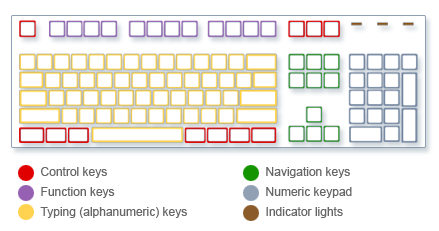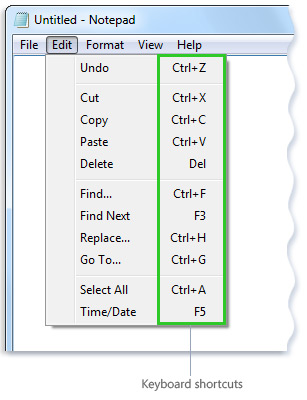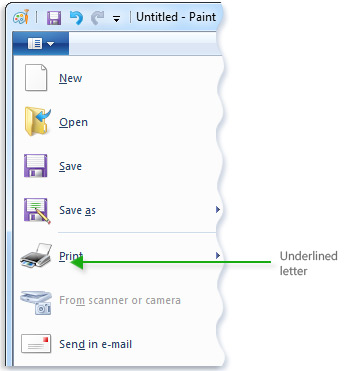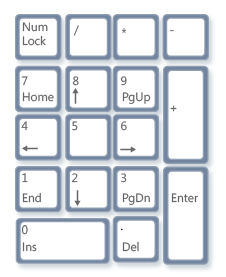What are the three data types that we are able to input from the keyboard?
Whether you're writing a letter or calculating numerical data, your keyboard is the main way to enter information into your figurer. But did you lot know y'all can as well use your keyboard to command your computer? Learning a few unproblematic keyboard commands(instructions to your computer) can help you work more efficiently.
How the keys are organized
The keys on your keyboard tin be divided into several groups based on role:
-
Typing (alphanumeric) keys. These keys include the aforementioned letter, number, punctuation, and symbol keys plant on a traditional typewriter.
-
Control keys. These keys are used alone or in combination with other keys to perform certain actions. The most oft used command keys are Ctrl, Alt, the Windows logo key
 , and Esc.
, and Esc. -
Function keys. The function keys are used to perform specific tasks. They are labeled equally F1, F2, F3, and so on, upwards to F12. The functionality of these keys differs from program to program.
-
Navigation keys. These keys are used for moving effectually in documents or webpages and editing text. They include the arrow keys, Domicile, End, Folio Upward, Folio Down, Delete, and Insert.
-
Numeric keypad. The numeric keypad is handy for inbound numbers quickly. The keys are grouped together in a block similar a conventional calculator or adding machine.
The post-obit illustration shows how these keys are arranged on a typical keyboard. Your keyboard layout might exist different.

Typing text
Whenever you lot need to type something in a plan, e‑mail message, or text box, yous'll see a blinking vertical line ( ) called the cursor or insertion betoken. It shows where the text that you lot type will begin. You can move the cursor by clicking in the desired location with the mouse, or by using the navigation keys (see the "Using navigation keys" section of this commodity).
) called the cursor or insertion betoken. It shows where the text that you lot type will begin. You can move the cursor by clicking in the desired location with the mouse, or by using the navigation keys (see the "Using navigation keys" section of this commodity).
In addition to letters, numerals, punctuation marks, and symbols, the typing keys likewise include Shift, Caps Lock, Tab, Enter, the Spacebar, and Backspace.
| Key name | How to utilize it |
|---|---|
| Shift | Printing Shift in combination with a letter to type an capital letter letter of the alphabet. Press Shift in combination with another key to type the symbol shown on the upper office of that key. |
| Caps Lock | Press Caps Lock once to type all letters as uppercase. Press Caps Lock again to turn this role off. Your keyboard might accept a light indicating whether Caps Lock is on. |
| Tab | Printing Tab to movement the cursor several spaces forward. You can likewise press Tab to move to the next text box on a form. |
| Enter | Printing Enter to motility the cursor to the beginning of the next line. In a dialog box, press Enter to select the highlighted button. |
| Spacebar | Press the Spacebar to move the cursor i space forwards. |
| Backspace | Printing Backspace to delete the character before the cursor, or the selected text. |
Using keyboard shortcuts
Keyboard shortcutsare means to perform actions by using your keyboard. They're called shortcuts because they help you piece of work faster. In fact, virtually any action or command you lot tin can perform with a mouse can be performed faster using one or more keys on your keyboard.
In Help topics, a plus sign (+) between 2 or more keys indicates that those keys should exist pressed in combination. For instance, Ctrl + A means to printing and concur Ctrl and then press A. Ctrl + Shift + A ways to printing and hold Ctrl and Shift and so press A.
Find plan shortcuts
You lot can do things in most programs by using the keyboard. To come across which commands accept keyboard shortcuts, open a menu. The shortcuts (if bachelor) are shown side by side to the menu items.

Keyboard shortcuts announced next to menu items.
Choose menus, commands, and options
You can open menus and choose commands and other options using your keyboard. In a plan that has menus with underlined letters, printing Alt and an underlined letter to open up the corresponding carte du jour. Press the underlined letter in a menu detail to choose that command. For programs that apply the ribbon, such equally Paint and WordPad, pressing Alt overlays (rather than underlines) a letter of the alphabet that can be pressed.

Press Alt + F to open the File carte du jour, and then press P to choose the Print control.
This flim-flam works in dialog boxes too. Whenever you encounter an underlined letter attached to an option in a dialog box, it means yous can press Alt plus that letter to choose that option.
Useful shortcuts
The following tabular array lists some of the near useful keyboard shortcuts. For a more detailed list, see Keyboard shortcuts.
| Press this | To practice this |
|---|---|
| Windows logo key | Open the Showtime carte du jour |
| Alt + Tab | Switch betwixt open programs or windows |
| Alt + F4 | Close the active detail, or go out the active programme |
| Ctrl + S | Relieve the current file or certificate (works in most programs) |
| Ctrl + C | Re-create the selected item |
| Ctrl + X | Cut the selected item |
| Ctrl + V | Paste the selected item |
| Ctrl + Z | Undo an action |
| Ctrl + A | Select all items in a document or window |
| F1 | Display Aid for a program or Windows |
| Windows logo fundamental | Display Windows Aid and Support |
| Esc | Cancel the current task |
| Application fundamental | Open a card of commands related to a pick in a programme. Equivalent to right-clicking the option. |
Using navigation keys
The navigation keys allow you to move the cursor, move around in documents and webpages, and edit text. The post-obit tabular array lists some mutual functions of these keys.
| Press this | To do this |
|---|---|
| Left Arrow, Right Arrow, Up Arrow, or Down Arrow | Move the cursor or choice i infinite or line in the management of the arrow, or curl a webpage in the direction of the pointer |
| Domicile | Move the cursor to the finish of a line or move to the pinnacle of a webpage |
| End | Motion the cursor to the end of a line or move to the bottom of a webpage |
| Ctrl + Abode | Movement to the top of a document |
| Ctrl + Stop | Move to the bottom of a document |
| Page Up | Movement the cursor or page up one screen |
| Page Downward | Motility the cursor or page downwards one screen |
| Delete | Delete the grapheme after the cursor, or the selected text; in Windows, delete the selected particular and motility information technology to the Recycle Bin |
| Insert | Turn Insert mode off or on. When Insert fashion is on, text that you lot type is inserted at the cursor. When Insert way is off, text that you type replaces existing characters. |
Using the numeric keypad
The numeric keypad arranges the numerals 0 though 9, the arithmetics operators + (addition), - (subtraction), * (multiplication), and / (division), and the decimal point as they would announced on a calculator or adding machine. These characters are duplicated elsewhere on the keyboard, of course, but the keypad arrangement allows you to rapidly enter numerical data or mathematical operations with one manus.

Numeric Keyboard
To employ the numeric keypad to enter numbers, printing Num Lock. Most keyboards accept a light that indicates whether Num Lock is on or off. When Num Lock is off, the numeric keypad functions equally a second set of navigation keys (these functions are printed on the keys next to the numerals or symbols).
You can use your numeric keypad to perform simple calculations with Figurer.
-
Open Calculator past clicking the Starting time button . In the search box, type Calculator, and so, in the list of results, click Calculator.
-
Check your keyboard lite to see if Num Lock is on. If it isn't, press Num Lock.
-
Using the numeric keypad, blazon the beginning number in the adding.
-
On the keypad, type + to add together, - to decrease, * to multiply, or / to divide.
-
Type the side by side number in the calculation.
-
Press Enter to complete the calculation.
Three odd keys
Then far, we've discussed nigh every key you're probable to use. But for the truly inquisitive, let's explore the three most mysterious keys on the keyboard: PrtScn, Scroll Lock, and Break/Interruption.
PrtScn (or Print Screen)
A long fourth dimension agone, this primal actually did what it says—it sent the current screen of text to your printer. Nowadays, pressing PrtScn captures an prototype of your entire screen (a "screen shot") and copies it to the Clipboard in your computer's memory. From there you can paste it (Ctrl + 5) into Microsoft Paint or another plan and, if you desire, impress it from that program.
More obscure is SYS RQ, which shares the key with PrtScn on some keyboards. Historically, SYS RQ was designed to be a "system request," but this control is not enabled in Windows.
Tip:Press Alt + PrtScn to capture an paradigm of merely the active window, instead of the entire screen.
ScrLk (or Scroll Lock)
In nearly programs, pressing Scroll Lock has no upshot. In a few programs, pressing Scroll Lock changes the behavior of the arrow keys and the Folio Upwardly and Page Down keys; pressing these keys causes the certificate to scroll without changing the position of the cursor or option. Your keyboard might have a calorie-free indicating whether Scroll Lock is on.
Suspension/Pause
This primal is rarely used. In some older programs, pressing this fundamental pauses the program or, in combination with Ctrl, stops information technology from running.
Other keys
Some modern keyboards come with "hot keys" or buttons that requite you quick, one-press access to programs, files, or commands. Other models take book controls, scroll wheels, zoom wheels, and other gadgets. For details nigh these features, check the information that came with your keyboard or computer, or get to the manufacturer's website.
Tips for using your keyboard safely
Using your keyboard properly can help avoid soreness or injury to your wrists, hands, and arms, especially if you employ your figurer for long periods. Here are a few tips to help improve keyboard use:
-
Identify your keyboard at elbow level. Your upper arms should be relaxed at your sides.
-
Center your keyboard in front of you. If your keyboard has a numeric keypad, y'all can utilise the spacebar as the centering point.
-
Type with your easily and wrists floating above the keyboard, so that you lot tin apply your whole arm to attain for distant keys instead of stretching your fingers.
-
Avoid resting your palms or wrists on any type of surface while typing. If your keyboard has a palm rest, use it only during breaks from typing.
-
While typing, apply a light impact and keep your wrists straight.
-
When you're not typing, relax your artillery and hands.
-
Have short breaks from computer use every 15 to xx minutes.
Source: https://support.microsoft.com/en-us/windows/using-your-keyboard-18b2efc1-9e32-ba5a-0896-676f9f3b994f
0 Response to "What are the three data types that we are able to input from the keyboard?"
Post a Comment